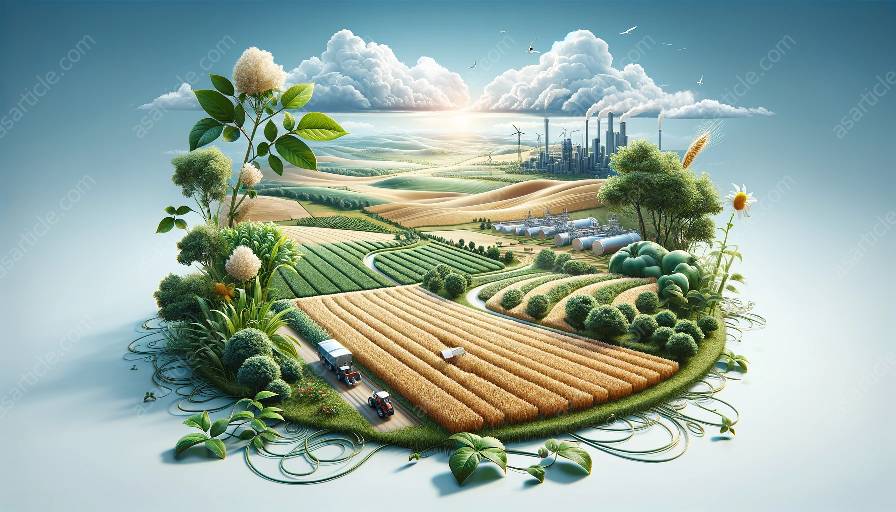Agroforestry is a sustainable land use management system that integrates trees and shrubs into agricultural production, offering numerous benefits for climate change mitigation and adaptation. This practice, rooted in agricultural sciences, presents a promising solution to address the challenges posed by climate change.
The Impact of Agroforestry on Climate Change
Agroforestry systems play a significant role in reducing greenhouse gas emissions, enhancing carbon sequestration, and contributing to climate change resilience. By combining trees and crops, these systems help maintain soil health and reduce erosion, which are crucial factors for sustainable agriculture in the face of changing climate patterns.
Enhancing Carbon Sequestration
Agroforestry contributes to carbon sequestration by enhancing the capture and storage of carbon in both aboveground and belowground biomass. Trees act as carbon sinks, sequestering atmospheric carbon dioxide and reducing its concentration in the atmosphere.
Reducing Greenhouse Gas Emissions
By promoting diverse plant cover and reducing the need for chemical inputs, agroforestry systems help lower greenhouse gas emissions associated with conventional agricultural practices. This shift towards sustainable land management contributes to climate change mitigation.
Promoting Climate Resilience
Agroforestry enhances ecosystem resilience by creating diverse and interconnected habitats that support biodiversity and ecosystem services. The trees' deep root systems also help increase soil moisture retention, making agroforestry systems more resilient to extreme weather events and changing precipitation patterns.
Adaptation Strategies through Agroforestry
Agroforestry presents adaptable and resilient solutions to manage agricultural landscapes in the context of climate change. As part of agricultural sciences, agroforestry offers a range of strategies to cope with climate-related challenges.
Enhancing Water and Soil Conservation
Agroforestry practices, such as alley cropping and contour planting, help minimize soil erosion and improve water retention in agricultural areas, thereby mitigating the impacts of erratic rainfall and droughts induced by climate change.
Providing Shade and Shelter
Tree-based agroforestry systems provide shade and shelter to crops and livestock, helping mitigate the effects of extreme temperature events and creating microclimatic conditions that are more favorable for agricultural productivity.
Diversifying Income Sources
Integrating trees into agricultural lands diversifies the sources of income for farmers, making their livelihoods more resilient to the economic impacts of climate change. The products derived from trees, such as fruits, nuts, and timber, offer alternative revenue streams and reduce dependency on traditional crop yields.
Policy Implications and Future Potential
The integration of agroforestry in climate change adaptation and mitigation strategies calls for supportive policies and investment in research and capacity building. As a vital component of agricultural sciences, agroforestry holds significant potential to shape sustainable and climate-resilient agricultural landscapes in the future.
Policy Support for Agroforestry
Governments and international organizations are increasingly recognizing the value of agroforestry in climate change adaptation and mitigation. Policy frameworks that support agroforestry can incentivize farmers to adopt sustainable land management practices and create favorable conditions for the expansion of agroforestry systems.
Research and Innovation
Advancements in agroforestry research and innovation can further enhance the understanding of the relationship between agroforestry and climate change. This can lead to the development of improved agroforestry practices and the identification of suitable tree-crop combinations for different agroecological zones.
Capacity Building and Knowledge Sharing
Efforts to build capacity among farmers, extension agents, and land managers in agroforestry techniques and best practices are essential for widespread adoption. Knowledge sharing platforms and extension services can play a pivotal role in disseminating information on the benefits of agroforestry for climate change resilience and encouraging its integration into agricultural systems.
Conclusion
Agroforestry offers a sustainable and holistic approach to address the challenges posed by climate change in agriculture. Its integration of trees and shrubs into agricultural landscapes not only contributes to climate change mitigation and adaptation but also fosters resilient and diversified farming systems. As the agricultural sciences continue to evolve, agroforestry stands at the forefront of sustainable solutions to meet the growing demands of a changing climate.

